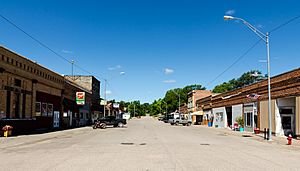Newcastle, Nebraska facts for kids
Quick facts for kids
Newcastle, Nebraska
|
|
|---|---|
|
Village
|
|

Main Street in Newcastle, June 2017
|
|

Location of Newcastle, Nebraska
|
|
| Country | United States |
| State | Nebraska |
| County | Dixon |
| Area | |
| • Total | 0.34 sq mi (0.88 km2) |
| • Land | 0.34 sq mi (0.88 km2) |
| • Water | 0.00 sq mi (0.00 km2) |
| Elevation | 1,289 ft (393 m) |
| Population
(2020)
|
|
| • Total | 272 |
| • Density | 804.73/sq mi (310.49/km2) |
| Time zone | UTC-6 (Central (CST)) |
| • Summer (DST) | UTC-5 (CDT) |
| ZIP code |
68757
|
| Area code(s) | 402 |
| FIPS code | 31-34090 |
| GNIS feature ID | 2399491 |
Newcastle is a small village located in Dixon County, Nebraska, in the United States. It's part of the larger Sioux City area, which includes parts of Iowa, Nebraska, and South Dakota. In 2020, about 272 people lived in Newcastle.
Contents
A Look at Newcastle's Past
Newcastle became an official village in 1893. This happened soon after the Chicago, St. Paul, Minneapolis and Omaha Railway built its tracks to the area. Some people say the village got its name from a pioneer's house that locals called the "new castle."
Fun Labor Day Traditions
Every year, Newcastle hosts a special Labor Day celebration. Many people come to enjoy the activities. These include an afternoon parade, exciting fire hose water fights, and a display of old-fashioned wheat threshing. This shows how wheat was harvested long ago.
The Mystery of the Ionia Volcano
Newcastle has a long history with a nearby abandoned town called Ionia. The area is marked as a historical site in Nebraska. This is because the famous explorers Lewis and Clark camped nearby. They also wrote about something called the "Ionia volcano" in their journals. Local people in the late 1800s also mentioned this "volcano" in a county history book.
Where is Newcastle Located?
Newcastle is a small village. It covers about 0.34 square miles (0.88 square kilometers) of land. There is no water area within the village limits.
The Ionia Volcano: A Natural Wonder
Close to Newcastle, you can find the site of the Ionia Volcano. This isn't a real volcano that erupts lava. Instead, it was a special mineral deposit found in cliffs along the Missouri River. Water from the river would seep into cracks in the cliffs. This caused steam to rise, making it look like a volcano. Most of this "volcano" washed away into the river in the 1870s. Today, the site is actually more than a mile away from the river.
People of Newcastle
| Historical population | |||
|---|---|---|---|
| Census | Pop. | %± | |
| 1900 | 331 | — | |
| 1910 | 436 | 31.7% | |
| 1920 | 500 | 14.7% | |
| 1930 | 446 | −10.8% | |
| 1940 | 447 | 0.2% | |
| 1950 | 426 | −4.7% | |
| 1960 | 357 | −16.2% | |
| 1970 | 347 | −2.8% | |
| 1980 | 348 | 0.3% | |
| 1990 | 271 | −22.1% | |
| 2000 | 299 | 10.3% | |
| 2010 | 325 | 8.7% | |
| 2020 | 272 | −16.3% | |
| U.S. Decennial Census | |||
The number of people living in Newcastle has changed over the years. You can see how the population has grown and shrunk since 1900 in the chart above.
What the 2010 Census Showed
In 2010, there were 325 people living in Newcastle. These people lived in 139 homes. About 84 of these homes were families. Most of the people in the village (99.7%) were White. A small number (2.8%) were Hispanic or Latino.
The average age of people in Newcastle was about 39.9 years old.
- About 27.1% of residents were under 18 years old.
- About 18.2% of residents were 65 years old or older.
- The village had slightly more females (52.0%) than males (48.0%).
See also
 In Spanish: Newcastle (Nebraska) para niños
In Spanish: Newcastle (Nebraska) para niños

